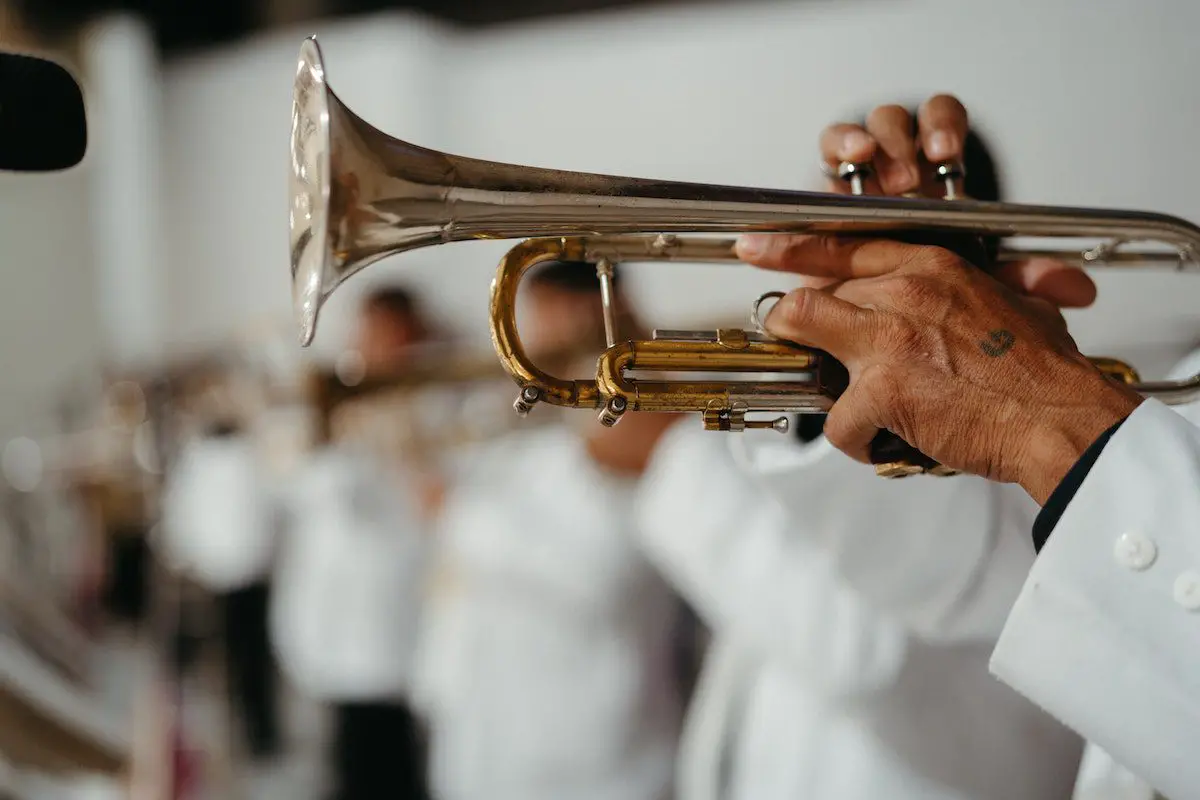Have you ever heard a trumpet, trombone, or French horn? These are all examples of brass instruments! These instruments have been around for centuries and have gone through quite an evolution to get to the point where they are today. So what exactly is a brass instrument? Keep reading as we explore their distinctive characteristics, the techniques used to master them, and the musicians who have pioneered their sound.
What is a brass instrument? A brass instrument is a type of metallic instrument made of brass tubes that generates sound through the vibration of air, instigated by the player’s lips against a tubular resonator.
What is a brass instrument?
You probably know that brass instruments are made of brass, but did you know they’re classified as aerophones and produce sound through air vibrations? Brass instruments work by buzzing the player’s lips against a cup-shaped mouthpiece. This causes the air inside the pipe to vibrate, which then produces sound.

These instruments also feature valves attached to the long pipes, which help control the pitch of the notes being played. So whether it’s a trumpet, French horn, trombone, or tuba – all these instruments are essentially very long pipes that widen at their ends into a bell-like shape.
AKAI Professional MPK Mini MK3

AKAI Professional MPK Mini MK3
A brief history of brass instruments
Brass instruments can play louder than other instruments and have been used throughout history to sound alarms, gather people together, and add luster to parade music. Some cultures used horns made from wood, tusks, animal horns, or shells as early as 3500 BC. While not brass, surely, there’s surely an argument to be made that these early-horned instruments were a predecessor of the brass instruments we know today.
The first metal trumpets can be traced back to 1500 BC in Egypt. According to ipassio.com’s Introduction to Brass Instruments, it was during the Middle Ages, around the 11th century, that brass instruments started to take on a resemblance to the ones we commonly use today.
These instruments were named ‘brass’ because they were made entirely out of brass pipes that had been curved and twisted into different shapes to make them easier to hold and play. Some of these instruments also had valves attached to their long pipes which allowed musicians to control the air pressure inside them and change pitch accordingly.
…it was during the Middle Ages, around the 11th century, that brass instruments started to take on a resemblance to the ones we commonly use today.
Southern Italy saw the emergence of the buisine, a medieval fanfare trumpet, which eventually became the direct precursor to all modern brass wind instruments.
What are the different types of brass instruments?
Today, there are a variety of brass instruments, and some of the most common types are:
- Trumpets are the smallest instrument in the family and produce the highest pitches with their bright and vibrant sound. They have three attached valves, and usually, there are two to four trumpets in an orchestra.
- French horns originated from France, producing a wide range of sounds ranging from very loud to very soft. It is composed of 18 feet long tubing rolled up into a circular shape with a bell at its end. Usually, two to eight French horns play in an orchestra.
- The trombone is unique among brass instruments for using a slide instead of valves to change pitch. It has nine feet-long straight pipe when stretched out fully. There are generally three trombones playing harmonies in an orchestra together with cello and bassoon pitch ranges.
- The tuba is the largest and lowest brass instrument which anchors the whole orchestra’s harmony with its deep rich sound. Standard tubas have about 16 feet long tubing while only one plays in an ensemble usually playing harmony as well.
- The cornet, often mistaken for a trumpet, has a softer, mellower sound due to its conical bore. It’s often used in brass bands where it shines for its melodic capabilities. Check out our cornet post here.
- The euphonium, on the other hand, is like the tuba’s little sibling. It shares a similar shape and sound but is smaller and lighter. If you’re into that deep, warm sound but find the tuba a bit too intimidating, the euphonium might be your jam.
Pitch and range of brass instruments
This table presents the fundamental pitch and general musical range of various brass instruments, showing the lowest and highest notes that each instrument can typically play.
| Instrument | Pitch | Range |
|---|---|---|
| Trumpet | B♭ | F♯3 – D6 |
| French Horn | F/B♭ | F2 – C6 |
| Trombone | C | E2 – F5 |
| Euphonium | B♭ | B1 – B♭5 |
| Tuba | C/F | D1 – F4 |
| Cornet | B♭ | A♭3 – E6 |
| Flugelhorn | B♭ | F3 – B♭5 |
| Sousaphone | B♭ | D1 – F4 |
| Mellophone | F | F2 – F5 |
What are some techniques for playing brass instruments?
Musicians of brass instruments have long used techniques such as circular breathing, mutes, and trills to create various tones. Let’s break down three essential techniques that brass musicians might want to master:
- Circular breathing: This technique allows the musician to continuously produce sound without taking a breath by using air stored in their cheeks while they inhale through their nose at the same time.
- Mutes: These accessories are placed inside or over the bell of the instrument to alter its tone and volume of it, making it quieter or brighter depending on the type of mute used.
- Trills: This technique involves rapidly alternating between two notes, which produces a vibrato effect that can be used for ornamentation or articulation in music.

Who are some notable brass musicians?
Throughout history, many talented musicians have helped shape the sound of brass instruments in music. Today, some of the most notable brass musicians come from a variety of backgrounds and bring different styles to their performances.
- Ambrose Akinmusire is an American jazz trumpeter who has released several albums and performed with artists like Herbie Hancock and Robert Glasper.
- Arturo Sandoval is a Cuban-born trumpeter who has collaborated with a wide range of renowned artists including Dizzy Gillespie, Johnny Mathis, Frank Sinatra and Justin Timberlake.
- Claudio Roditi is a Brazilian trumpet player whose unique style blends together bebop, Afro-Cuban rhythms, and Brazilian music.
- John Swana is an American jazz musician who won several awards for his work on both trumpet and flugelhorn during his long career.
- Raul de Souza was a Grammy Award-winning trombonist from Brazil best known for his work with Hermeto Pascoal’s group ‘O Grupo’ during the 1970s.
- Ryan Kisor is an American trumpeter known for his fusion of Jazz and Rock styles in compositions like ‘Echoes From The Burning Bush’ which he wrote for Wynton Marsalis’ orchestra at Lincoln Center Jazz Orchestra (LCJO).
Advantages and disadvantages of playing brass instruments
Choosing to play a brass instrument comes with its own set of benefits and challenges. Let’s lay it all on the line and take a look at the pros and cons of picking up a brass instrument.
Advantages of brass instruments
Brass instruments have a lot going for them. Here are some of the benefits:
- Dynamic Range: Brass instruments are versatile and can play both loudly and softly.
- Rich Sound: These instruments produce a warm, resonant sound that’s hard to beat.
- Visual Appeal: Let’s face it, there’s something majestic about the gleam of a brass instrument on stage.
- Wide Use: Brass instruments are used in a variety of music genres, giving players plenty of opportunities to perform.
Disadvantages of brass instruments
But just like anything else, there are some challenges that come with playing a brass instrument:
- Physical Demand: Playing a brass instrument can be physically demanding, especially for the lips and the breath control needed.
- Maintenance: Brass instruments require regular cleaning and maintenance to keep them in top shape.
- Learning Curve: It can take time and patience to master the unique techniques needed to play these instruments.
- Size and Weight: Some brass instruments, like the tuba, are large and heavy, making them more difficult to transport.
If you want even more great tips and information, check out the video below.
Frequently Asked Questions (FAQ)
Below are some of the most commonly asked questions about brass instruments that we haven’t addressed yet.
What is the difference between a brass instrument and a woodwind instrument?
A brass instrument is like a bright, shiny beacon compared to the woodwind’s mellow whisper. Brass instruments produce sound by buzzing lips against a metal cup-shaped mouthpiece while woodwinds use reeds. Trumpets, trombones and tubas are examples of brass instruments; flutes, clarinets, and oboes are types of woodwinds.
How often should I clean my brass instrument?
Cleaning your brass instrument is an essential part of its maintenance. Depending on how frequently you play, it’s generally recommended to give it a thorough cleaning every three to four months. Regular cleaning helps maintain the instrument’s tone quality and extends its lifespan.
What’s the difference between a cornet and a trumpet?
While both the cornet and trumpet are common brass instruments and bear a close resemblance, their differences lie in their design and sound. The cornet has a more conical bore, giving it a softer and mellower tone, whereas the trumpet, with its cylindrical bore, produces a brighter and more piercing sound.
Is it harder to play a low-brass instrument than a high-brass instrument?
Low brass instruments like the tuba or euphonium may require more breath control due to their larger size. However, high brass instruments like the trumpet might require more lip flexibility to hit those higher notes. Ultimately, it’s about finding the instrument that suits you best.
Conclusion
And there we have it, folks—a quick tour through the brass-tastic world of, well, brass instruments! Have I hit the right notes in covering everything you wanted to know about brass instruments? Let me know in the comments section below—I read and reply to every comment. If this article was music to your ears, don’t keep it to yourself. Share it with a friend, and check out my full blog for more. Thanks for reading and keep making that brass sing!
Key Takeaways
- Brass instruments are essentially long pipes that widen at their ends into a bell-like shape and are made (usually) entirely of brass.
- Brass players use their breath to produce sound by buzzing their lips against a metal cup-shaped mouthpiece and most brass instruments have valves attached to their long pipes.
- Trumpet, French horn, trombone, and tuba are the most commonly used brass instruments, with each having unique characteristics and playing ranges.
- Brass instruments can play louder than any other instrument in the orchestra and have been used throughout history to sound alarms, gather people together, and add luster to parade music.















